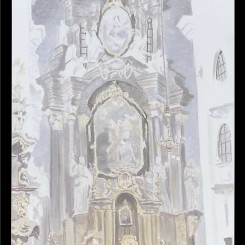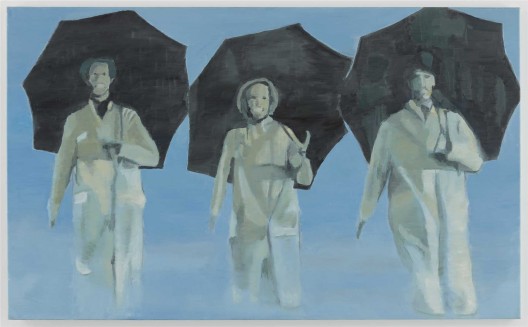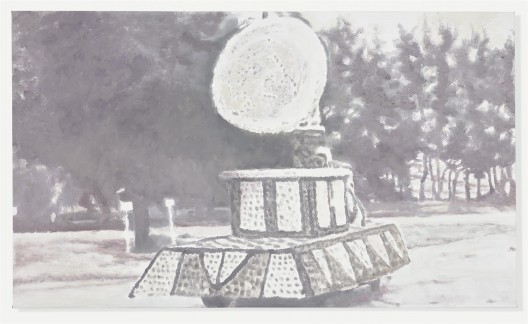by Iona Whittaker
This piece is included in Ran Dian’s print magazine, issue 4 (Winter 2016–2017)
In an age in which he feels artists have become exceedingly democratic, Luc Tuymans adheres closely to the method he has honed over time—mercifully without, he says, a moment of “painter’s block.” Now fifty-eight, Tuymans had his first solo exhibition in his native Belgium when he was twenty-seven. His commitment to painting is sometimes discussed in near-messianic terms, and it is true that his work has never wavered from an approach to subject matter and technique that simultaneously flattens and deeply probes them. His paintings conjure up preexisting imagery (taken from the internet, Polaroids, magazine and newspaper clippings, TV footage, and other sources) with a lightness that can feel almost painful. In his own words, Tuymans “Doesn’t want to think on the surface of the painting”: conceptualized over a long period of time, his works, once begun, are executed from the very faintest to the highest level of contrast. The resulting effects are often ghostly or suspiciously wan, making for an implicit critique of the times from which they are drawn.
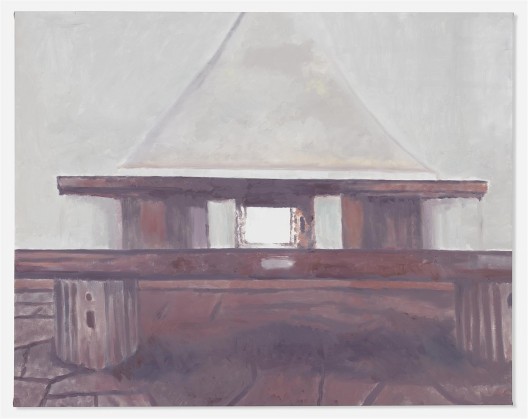
吕克·图伊曼斯,《蔑视》,布面油画,112.4 × 142.6 cm,2015(图片由伦敦/纽约大卫·茨维尔纳画廊提供)/ Luc Tuymans, “Le Mépris”, oil on canvas, 112.4 × 142.6 cm, 2015. Courtesy David Zwirner, New York/London.
Iona Whittaker: People say that much more is made now of the personality of the artist; I’m not sure if that is necessarily true. It may be about the personality of the artist in a different way— about trying to obtain more intimate knowledge of what their life is like, or what they are like.
Luc Tuymans: That’s total crap. My work is not me; I’m not my work— don’t try to find the man behind the work and that shit. A lot of people try to do that, and it’s just not interesting. I mean, it’s also what the work is about, basically. At some point there are probably artists working on a very personal level or who are women or feminists or guys who are black—but I’m not that. I’m not an African American; I’m not a woman; I’m not transgender. I’m just Caucasian. I’m not even sure I’m Jewish! So all those things don’t really matter. The only thing that would matter is that I come from Antwerp, which is a city-state full of smart-asses, which is why I never liked New York, because it’s too similar to where I come from. There’s a lot of talk, a lot of baloney, a lot of hot air. I never liked it. It must have been great in the ’70s, ’60s, and ’80s. But I came here far too late.
Iona Whittaker: I read an article explaining that people always say their city was better “back then,” but that it’s really about them having been (or felt) “better” or younger at that time.
Luc Tuymans: No, I know a couple of old New Yorkers like Alex Katz and I mean … argh. I meet all these people. Ellsworth Kelly I used to know, too, and Brice Marden. That sense of humor is no longer alive, and if you meet these old guys it’s really refreshing because at least they can make a joke. But that’s a global thing, it’s not only New York.
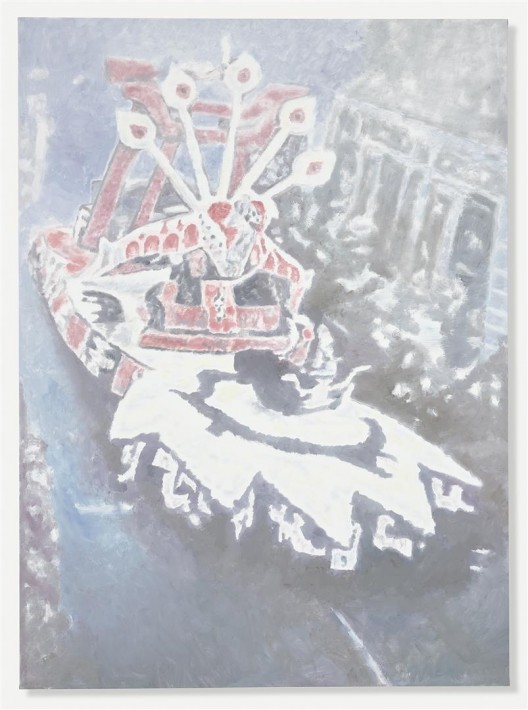
吕克·图伊曼斯,《科尔索I》,布面油画,250.8 × 184.5 cm,2015(图片由伦敦/纽约大卫·茨维尔纳画廊提供)/ Luc Tuymans, “Corso I”, oil on canvas, 250.8 × 184.5 cm, 2015. Courtesy David Zwirner, New York/London.
Iona Whittaker: Without delving into your personality, there must be, by this point, certain habits or a method by which you work. Do you think you are comfortable in it?
Luc Tuymans: I’m actually still working the way I always worked. I work late in the day, which I’ve been doing for the last twenty-five, thirty years; it became organic and just like a habit. It’s amazing because I’ve never had “painter’s block” or anything like that. I’m also not the type of artist who gets bored easily; I can do one thing. So that means that other things are at stake but it also means that you have the possibility of … being surprised, and sometimes there’s agony in trying to find whatever thing you want to come up with.
I mostly come from a region where realism is the main thing. My region had been overrun by a lot of foreign powers like the Germans, so we have never had the chance to be Romantic, or so-called Enlightened or Rational like the French; we didn’t have that time. So we are really dealing with the real, and the reason to stay alive, which creates extreme individuals. I come from a country with no sense of a group and very little organization but extreme potential when it comes to the individual and the creativity on all levels—not only art but also science and writing. So, if you talk about Belgium, you don’t talk about Magritte, which most people do, or [James] Ensor, who is grotesque and is the precursor of Expressionism. Magritte is not even a surrealist: “Ceci n’est pas une pipe”—of course it is not a pipe, it is an image of a pipe; it is all about the real.
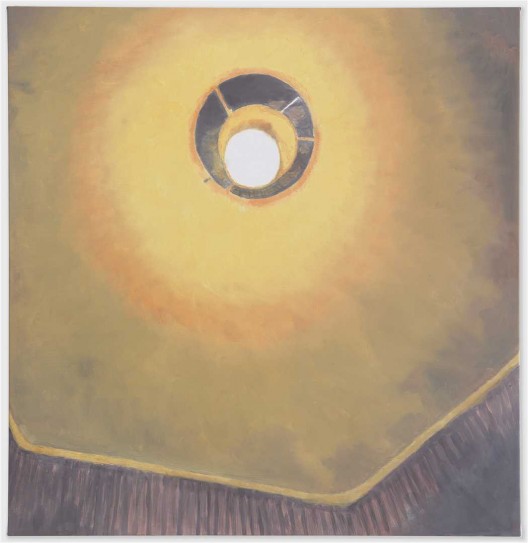
吕克·图伊曼斯,《灯泡》,布面油画,114.3 × 111.4 cm,2010(图片由伦敦/纽约大卫·茨维尔纳画廊提供)/ Luc Tuymans, “Light Bulb”, oil on canvas, 114.3 × 111.4 cm, 2010. Courtesy David Zwirner, New York/London.
Iona Whittaker: People must ask about truth relative to your painting.
Luc Tuymans: There is no truth in the work. I have a high distrust for images, even my own, so in a sense it’s not about truth. Pretty early on, when I was eighteen or something, I won a prize between all the academies with a self-portrait that I worked on for an entire month, every day. I was thinking differently then, but essentially in the same way. I thought: “Fuck, I’ll never make anything new.” So from there the idea sprung to make authentic falsifications. It was also a regressive role in order to position myself; in that era nobody painted, so it was very difficult to do. This was a way to conceptualize it, to make it possible. Of course, that changed; it was a very infantile concept, but it still was an interesting idea.
Truth is quite difficult to measure. There have of course been attempts by art historians—the October group and [Clement] Greenberg and all that, which were quite valid in their own way but are now totally obsolete. You get people like Hal Foster who don’t get it anymore. And these are the sort of intellectual guys who are just working out [that is, “exercising” —Ed.] nowadays.
Iona Whittaker: But to have maintained such a persistent pursuit amid a system that changes so much and that is ugly in a lot of ways—I’m not sure if that makes you comfortable, or uncomfortable?
Luc Tuymans: I’m lucky because I’m an established artist. To be a young artist right now must be really hard because there’s much more information and the gigantic mechanism of the art market, which is unbalanced because the value put on contemporary art is totally disproportionate. That’s one thing, the speculation. Another is that I know my generation, my standards. . . . But when do I meet them? Everything is completely isolated. People have too many projects; they travel a lot. There’s the market, but there’s no talk about content. This is a vacuum that’s been created. Duchamp came out of the sort of high-end middle class, and they had the salons and the writers—actually, up until the ’70s, it was still quite sympathetic. And then in 1990 the Gulf War happened, and all the little galleries went bankrupt, and thus the mechanism was installed. That’s what you see now.
That is of course something I have to deal with. I had never had a strategy, but once it started, I said, “Okay, I will take care of this”; I’ll do the interviews. I also have an office of people who control the whole thing—the archive, the transport and everything, the publications. I also curate shows. . . . In a sense that’s all possible, but that is the art world. That has nothing to do with making my artwork. This way, I can keep it out of my fucking studio. It’s a lot of work, but I’m a bit of a control freak so it’s better that I do it; otherwise, I’m going to be worried all the time. This is the way you have to create your space today, just to work! It’s insane. This is particularly true when you become famous. When you start out, you choose your own isolation. When you make it, this isolation becomes part of it. You have to take care of yourself, basically. Some can, some can’t. There’s an element of precision and timing, also.
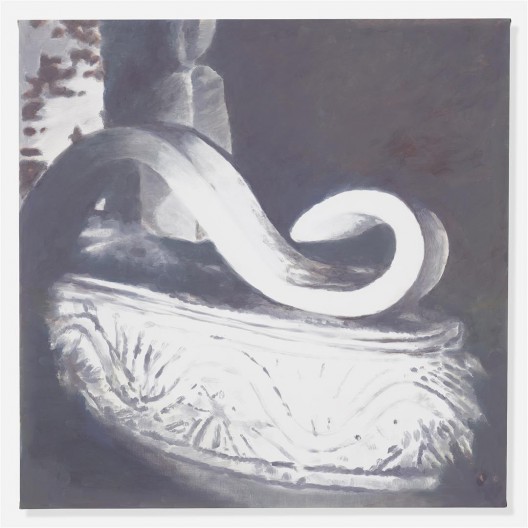
吕克·图伊曼斯,《模特》,布面油画,120.6 × 120.8 cm,2015(图片由伦敦/纽约大卫·茨维尔
纳画廊提供)/ Luc Tuymans, “Model”, oil on canvas, 120.6 × 120.8 cm, 2015. Courtesy David Zwirner, New York/London.
Iona Whittaker: Paintings are quite demanding in the sense that you must really stand in front of them; they want you to come into their remit and enter their world. On the scale you are working with, that is also true, but at the same time the lightness with which you paint and the way the light works in the paintings might counteract that. I’m not sure how or whether you imagine the person looking at it.
Luc Tuymans: A Russian woman, an art critic, mentioned once when I had a show in Moscow that what’s important is the distance measured between the image and the spectator. Painting, especially, has to be made at a certain distance—that’s why I have a mirror—and it has to work from a distance. If you come closer, it might completely evaporate.
Iona Whittaker: My tendency was always to get as close to paintings as possible, to see the brushstrokes.
Luc Tuymans: For me, that’s important—unlike, for example, Richter, in my work even blurriness is painted, so it’s very sharp. But that’s not something I want you to see first. I want you to see the image and then the painting.
Iona Whittaker: So you would rather someone walk toward it than step back?
Luc Tuymans: Yes, exactly.
Iona Whittaker: Have you always worked on this scale?
Luc Tuymans: No. Until 2006 I had quite a small studio. I think the width of the wall was maximum three and a half meters, so if I wanted to make something big, I had to rent something. Then I got a new space with better light, heating for the first time, and walls about four and a half meters high. That enabled me to make bigger things.
Iona Whittaker: I’m glad you have heating.
Luc Tuymans: Well yes, but not until 2006. I did have it but it broke down, and then it rained inside. It was really very Francis Bacon–like.
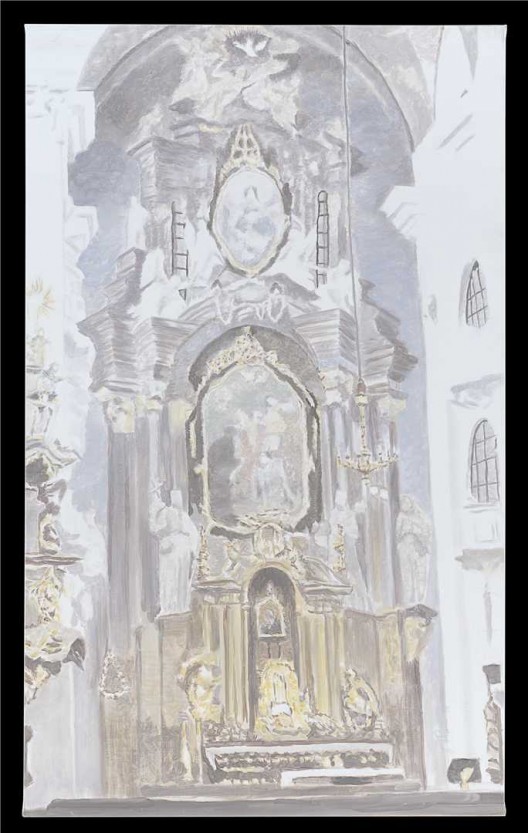
吕克·图伊曼斯,《教堂》,布面油画,235.5 × 142 cm,2006图片由伦敦/纽约大卫·茨维尔纳画廊提供)/ Luc Tuymans, “Church”, oil on canvas, 235.5 × 142 cm, 2006. Courtesy David Zwirner, New York/London.
Iona Whittaker: I like his quotes—“Champagne for my real friends and real pain for my sham friends.” Did you ever meet him?
Luc Tuymans: No, I never met Bacon. I met Lucian Freud. He was a great painter. It took a while for me to really appreciate Bacon, I have to say. I think he was a genuine artist. But the problem with Bacon is that he loved his paintings to be put behind glass. There was one moment in Tokyo where there was a big Bacon show, and I was able—because the lighting was off and wrong—to see through the glass to the surface of the painting. And that was quite enlightening. I mean, that’s one of the reasons why I didn’t get it before, because the glass was too much of a barrier.
Iona Whittaker: You have quite a gallery-mate at the moment (Jordan Wolfson’s new installation ”Colored Sculpture“, in which a jointed metal mannequin with recognition software is dragged about the floor on long chains to a loud, intermittent soundtrack—Ed).
Luc Tuymans: Yeah, the doll also says things. I think it’s actually okay. It’s a bit violent and it’s difficult to do it right because otherwise it gets like a gimmick. But it’s totally in opposition to what I’m doing. Juxtaposition is always there.
Iona Whittaker: It’s still relatively peaceful here, though.
I liked SoHo a lot before. It was a normal experience with normal people. Once the galleries moved here (Chelsea), it became very antiseptic. Also, I don’t think galleries should do museum shows. They do—David [Zwirner] did a giant Dan Flavin show across three spaces. Don’t you think that’s a bit odd? Museums should do that.
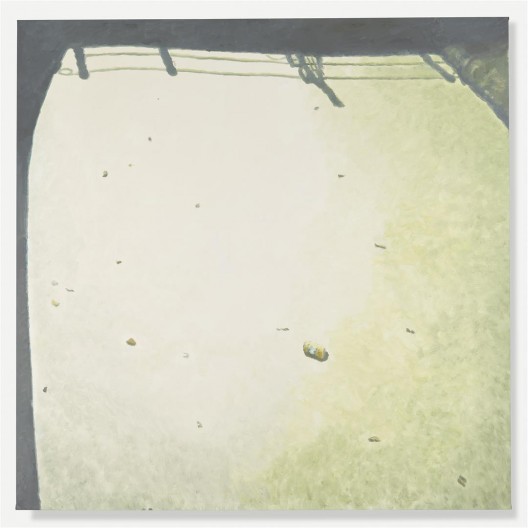
吕克·图伊曼斯,《浑浊之水I》,布面油画,235.5 × 235.5 cm,2015(图片由伦敦/纽约大卫·茨维尔
纳画廊提供)/ Luc Tuymans, “Murky Water I”, oil on canvas, 235.5 × 235.5 cm, 2015. Courtesy David Zwirner, New York/London.
Iona Whittaker: Are you ever tempted to “quit art,” as some artists have? Do you feel you still have a sufficient amount of say in how your work is shown and conducted?
Luc Tuymans: Yes, sure. Still, no work that hasn’t been approved by me is going to leave the studio. And because I started to show work pretty late— I was already thirty-two—I had the chance to do a humongous amount of self-censorship. This was not always good, because I also overpainted and destroyed works I shouldn’t have. But it makes it near impossible to get something bad out of the studio.
But painting is a fabulous medium because it works through time, to time, and over time. It is a slow medium in terms of perception. And in my case it’s something that fucks with your brain and your memory. There’s a beautiful story I always tell about a guy who is the director of a museum in Honolulu. He profoundly hated my work and he went to see the show at Tate Modern [in 2004] and hated it even more. And then he started dreaming about it, and he became my biggest fan! [Laughs loudly.] I think that sort of amplifies what I’m saying. Even for me, it sometimes takes a while to understand an artist. It took me a very long time to understand Andy Warhol. Then I saw a big retrospective of Warhol at the Centre Pompidou [in 1990]. When I came out of the show, I understood that black was really important for Warhol. By using silkscreen, he employed the authority of print; it’s an interesting take on reality. That’s when he became a very analytical artist for me, and when I could actually start to dig into it.
But I can look very quickly. If I go to a museum show, I’ll be out in about half an hour. I still remember seeing my very first Edward Hopper when I was something like twenty, in a Hayward Gallery show of American painting. I felt something in my back and turned around, and there was a Hopper—I didn’t even know what that was. The same with Friedrich; the same with other important things. You just sense it. There is a specific quality to those works that makes them not only survive but also sort of reenacts them every time you look at them, which is pretty scary in a way. But that’s where the admiration goes. If you look at a [Diego] Velázquez, it’s incredibly beautifully done, very economical. And it’s very harsh also in the sense that Velázquez is the guy who looks down on you: you’re just a fucking ant. Whereas Goya builds himself from the ground up. But now, Goya has become so annoying for me that I think he is more interesting—I can’t really figure him out. He’s not always a great painter, but he’s a very annoying artist. [Laughs.]
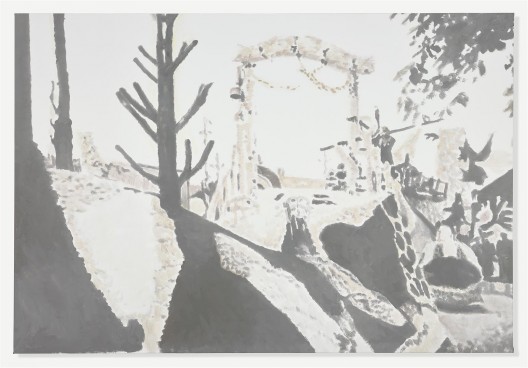
吕克·图伊曼斯,《科尔索IV》,布面油画,142.2 × 208 cm,2015(图片由伦敦/纽约大卫·茨维尔纳画廊提供)/ (Next page) Luc Tuymans, “Corso IV”, oil on canvas, 142.2 × 208 cm, 2015. Courtesy David Zwirner,
New York/London.
Iona Whittaker: I really like humor in art.
Luc Tuymans: Yes, absolutely, and things shouldn’t be taken too seriously, either. That’s a very important rule. There’s a lot of humor in my work— maybe it’s quite sardonic. They call it cynical but it’s not; it’s just sardonic. I don’t think you can afford to be cynical. Like the car with the big horn in this show [“Corso III”, 2015]—that’s a joke. There is always this element and layering, which I think is important because it has to do with something a bit more spiritual—not in a satiric sense but in a real sense. And that’s what you strive for, in a way, and what makes it interesting. I also still read a lot of fiction—it’s really important, especially in the age of the internet and Netflix and all that. Fiction is important because it keeps your brain alive. In the beginning all my friends were writers—very few visual artists.
Iona Whittaker: What do you read?
Luc Tuymans: I’ve read all the books by Murakami and Thomas Pynchon. Also classical stuff: I’ve read all the Russians and lots of German writers. I am also great friends with Will Self. I met him when I did my first show with Jay [Jopling, of White Cube]. My wife and I went to the Groucho bar with Jay, and Will Self was on the second floor talking to someone. He sees Jay, and he goes and takes a splash painting by Damien Hirst off the wall and throws it out of the window. Jay goes to get it back, and then Self throws it out of the window another three times. [Chuckles loudly.] And then we started to talk. We had a fight about Francis Bacon or something like that. And he said, “You arrogant bastard, have you looked at yourself?” So I bought his first novel, My Idea of Fun, and it was good, and so I wrote to him. And now he sends me every new book. I think he’s quite a good writer, and a pretty annoying person. It’s funny because I didn’t know the guy then, and this was really his very first novel.
Iona Whittaker: I like these connections you are describing.
Luc Tuymans: Yes. Relationships really come out of them and things remain, which I think is important. There is reciprocity.
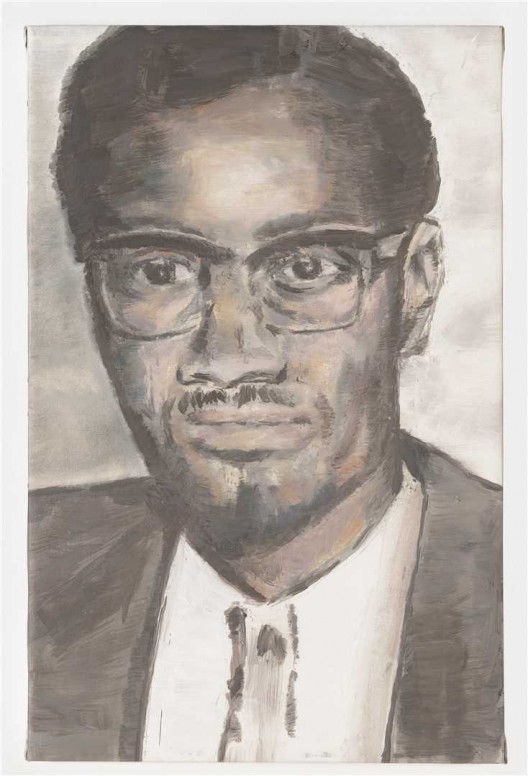
吕克·图伊曼斯,《卢蒙巴》,布面油画,62 × 46 cm,2000(图片由伦敦/纽约大卫·茨维尔纳
画廊提供)/ Luc Tuymans, “Lumumba”, oil on canvas, 62 × 46 cm, 2000. Courtesy David Zwirner, New York/London.

